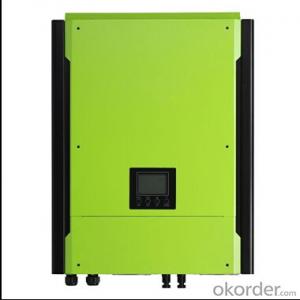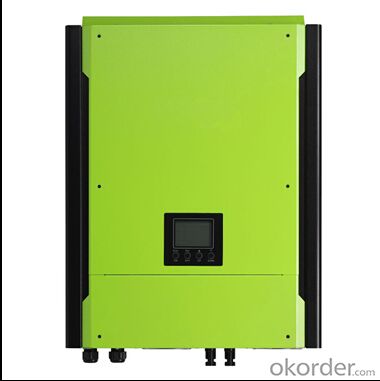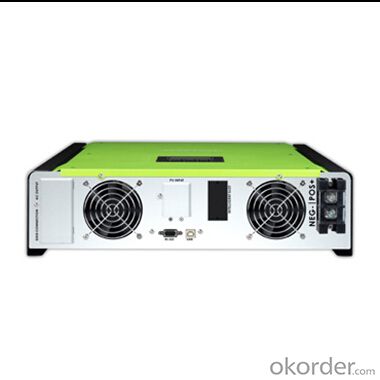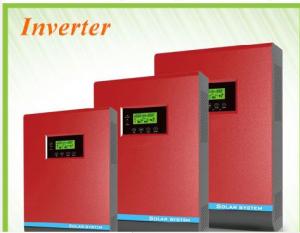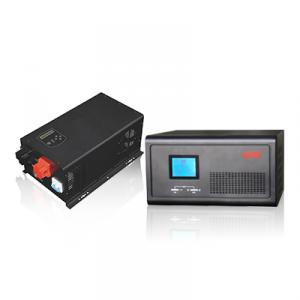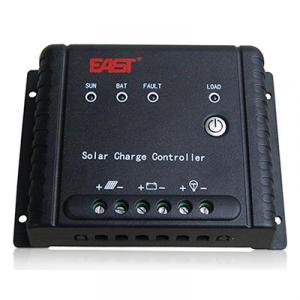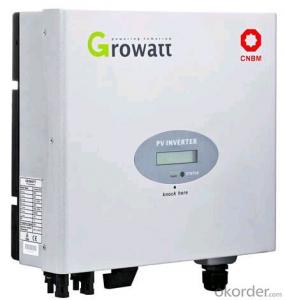400W Solar Inverter On-Grid Energy Storage PV Inverter PH500 Series 1-Phase 2KW
- Loading Port:
- China main port
- Payment Terms:
- TT or LC
- Min Order Qty:
- 60000 watt
- Supply Capability:
- 16000000 watt/month
OKorder Service Pledge
OKorder Financial Service
You Might Also Like
1. Structure of On-Grid Energy Storage PV Inverter Description
On-Grid Energy Storage PV Inverter is a hybrid inverter which combines solar system, AC utility, and battery power source to supply continuous power• It is suitable for the remote areas where the cost of utility is too high or emergency usage when utility is not stable.
2. Main Features of the On-Grid Energy Storage PV Inverter
• 2KW on-grid inverter with energy storage
• Pure sine wave output
• Microprocessor controlled to guarantee stable charging system
• Multiple operations: Grid tie, Off grid, and grid-tie with backup
• Built-in MPPT solar charger
• LCD display panel for comprehensive information
• Multiple communication
• Green substitution for generators
• User-adjustable battery charging current
3. On-Grid Energy Storage PV Inverter Images
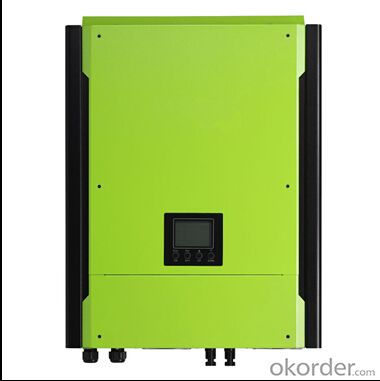
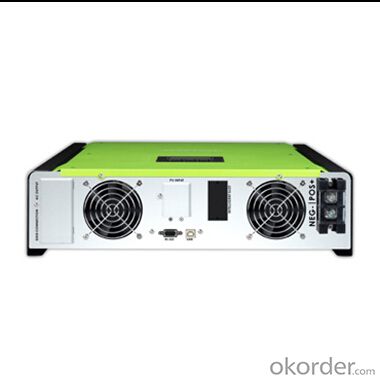
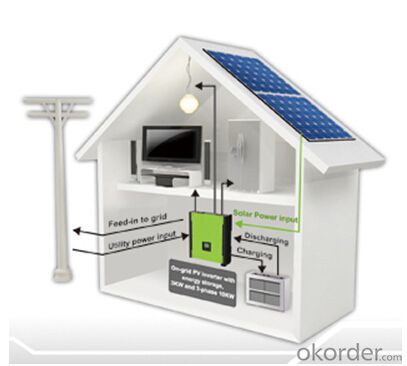
4. On-Grid Energy Storage PV Inverter Specification
Model | PH500 Single-phase 2KW |
RATED POWER | 2000 W |
GRID-TIE OPERATION | |
PV INPUT (DC) | |
Maximum DC Power | 2250W |
Nominal DC Voltage / Maximum DC Voltage | 300 VDC / 350 VDC |
Start-up Voltage / Initial Feeding Voltage | 80 VDC / 120 VDC |
MPP Voltage Range | 150 VDC ~ 320 VDC |
Number of MPP Trackers / Maximum Input Current | 1 / 1 x 15 A |
GRID OUTPUT (AC) | |
Nominal Output Voltage | 101/110/120/127 VAC |
Output Voltage Range | 88 - 127 VAC* |
Nominal Output Current | 18 A |
Power Factor | > 0.99 |
EFFICIENCY | |
Maximum Conversion Efficiency (DC/AC) | 0.95 |
European Efficiency@ Vnominal | 0.94 |
OFF-GRID OPERATION |
|
AC INPUT | |
AC Start-up Voltage/Auto Restart Voltage | 60 - 70 VAC / 85 VAC |
Acceptable Input Voltage Range | 85 - 130 VAC* |
Number of MPP Trackers / Maximum Input Current | 30 A |
PV INPUT (DC) | |
Maximum DC Voltage | 350 VDC |
MPP Voltage Range | 150 VDC ~ 320 VDC |
Maximum Input Current | 1 / 1 x 15 A |
BATTERY MODE OUTPUT (AC) | |
Nominal Output Voltage | 101/110/120/127 VAC |
Output Waveform | Pure Sinewave |
Efficiency (DC to AC) | 0.9 |
HYBRID OPERATION | |
PV INPUT (DC) | |
Nominal DC Voltage / Maximum DC Voltage | 300 VDC / 350 VDC |
Start-up Voltage / Initial Feeding Voltage | 80 VDC / 120 VDC |
MPP Voltage Range | 150 VDC ~ 320 VDC |
Maximum Input Current | 1 / 1 x 15 A |
GRID OUTPUT (AC) | |
Nominal Output Voltage | 101/110/120/127 VAC |
Output Voltage Range | 88-127 VAC |
Nominal Output Current | 18 A |
AC INPUT | |
AC Start-up Voltage/Auto Restart Voltage | 60 - 70 VAC / 85 VAC |
Acceptable Input Voltage Range | 80 - 130 VAC* |
Maximum AC Input Current | 30 A |
BATTERY MODE OUTPUT (AC) | |
Nominal Output Voltage | 101/110/120/127 VAC |
Efficiency (DC to AC) | 0.9 |
BATTERY & CHARGER | |
Nominal DC Voltage | 48 VDC |
Maximum Charging Current | 25A |
GENERAL | |
PHYSICAL | |
Dimension, D x W x H (mm) | 420 x 415 x 170 |
Net Weight (kgs) | 15.5 |
INTERFACE | |
Communication Port | RS-232/USB |
Intelligent Slot | Optional SNMP, Modbus, and AS-400 cards available |
ENVIRONMENT | |
Humidity | 0 ~ 90% RH (No condensing) |
Operating Temperature | 0 to 40°C |
Altitude | 0 ~ 1000 m** |
5. FAQ of On-Grid Energy Storage PV Inverter
Q1. What is the difference between inverter and On-Grid Energy Storage PV Inverter?
A1. Inverter only has AC inpput, but On-Grid Energy Storage PV Inverter both connect to AC input and solar panel, it saves more power.
Q2. What is the difference between MPPT&PWM?
A2. MPPT has higher efficiency, it can track the max power point and won't waste energy.
Q3. What is the waranty of product?
A3. 12 months.
- Q: What is the typical lifespan of the capacitors in a solar inverter?
- The typical lifespan of capacitors in a solar inverter can vary depending on various factors such as the quality of the capacitors, operating conditions, and maintenance practices. However, on average, capacitors in a solar inverter are expected to have a lifespan of around 10 to 15 years.
- Q: How is the efficiency of a solar inverter measured?
- The efficiency of a solar inverter is typically measured by comparing the amount of direct current (DC) power produced by the solar panels to the alternating current (AC) power delivered by the inverter. This measurement is known as the inverter efficiency and is expressed as a percentage. The higher the efficiency, the more effectively the inverter converts DC power into usable AC power, resulting in greater overall energy production from the solar system.
- Q: What is the maximum short-circuit current that a solar inverter can handle?
- The maximum short-circuit current that a solar inverter can handle depends on its specific design and specifications. It varies from one model to another, but typically, solar inverters are designed to handle short-circuit currents within the range of 10 to 25 times their maximum continuous output current. However, it is crucial to consult the manufacturer's guidelines or product specifications for the exact maximum short-circuit current rating of a specific solar inverter model.
- Q: What is the role of a maximum power point tracker (MPPT) in a solar inverter?
- The role of a maximum power point tracker (MPPT) in a solar inverter is to optimize the efficiency and power output of a solar panel system. Solar panels generate direct current (DC) electricity, but most appliances and the electrical grid operate on alternating current (AC). The MPPT is responsible for continuously adjusting the operating conditions of the solar panels to extract the maximum power available from the sunlight. It tracks the maximum power point (MPP) at which the solar panels can generate the most electricity efficiently. This is important because the output of a solar panel is highly dependent on factors such as temperature, shading, and the angle of the sun. By continuously monitoring and adjusting the voltage and current of the solar panel system, the MPPT ensures that the solar panels are always operating at the MPP, maximizing the power output. It achieves this by dynamically changing the electrical load on the solar panels to find the optimal operating point. The MPPT also acts as a converter, transforming the DC power generated by the solar panels into the AC power required for use by appliances or for feeding back into the electrical grid. This conversion process involves transforming the voltage and frequency of the electricity to match the requirements of the appliances or the grid. Overall, the role of a maximum power point tracker in a solar inverter is to optimize the efficiency and power output of the solar panel system, ensuring that the maximum amount of energy is harnessed from the sunlight and effectively utilized for various applications.
- Q: What is the role of a solar inverter in a residential system?
- The role of a solar inverter in a residential system is to convert the direct current (DC) electricity generated by the solar panels into alternating current (AC) electricity that is suitable for use in the home. It also manages the flow of electricity, monitors the system's performance, and ensures safety by providing protection against electrical faults.
- Q: How does a solar inverter handle voltage transients?
- A solar inverter handles voltage transients by employing various protective mechanisms such as surge protection devices and voltage regulation techniques. These mechanisms help to stabilize and control the voltage level, ensuring that the inverter is not affected by sudden spikes or drops in voltage. Additionally, the inverter may include features like overvoltage and undervoltage protection, which help to prevent damage to the system during voltage transients.
- Q: What is the role of a solar inverter in a solar-powered telecommunications system?
- The role of a solar inverter in a solar-powered telecommunications system is to convert the direct current (DC) electricity generated by the solar panels into alternating current (AC) electricity that can be used to power the telecommunications equipment. It also regulates the voltage and frequency of the electricity to ensure a stable and reliable power supply for the system.
- Q: Can a solar inverter be used in conjunction with a wind turbine?
- Indeed, a wind turbine can be utilized alongside a solar inverter. Both solar panels and wind turbines yield direct current (DC) electricity, necessitating conversion to alternating current (AC) for household and commercial usage. While solar inverters are specifically devised to convert DC power from solar panels to AC power, they can also accommodate DC power produced by wind turbines. By linking a wind turbine to a solar inverter, the DC power generated by the wind turbine can be transformed into AC power, enabling it to energize electrical appliances or be channeled into the power grid. This amalgamation of renewable energy sources, such as solar and wind, within a single system enhances the dependability and efficiency of energy generation.
- Q: Can a solar inverter be used with a single solar panel?
- Yes, a solar inverter can be used with a single solar panel. The purpose of a solar inverter is to convert the direct current (DC) produced by the solar panel into alternating current (AC) that can be used to power electrical devices or be fed into the electrical grid. Even with a single solar panel, the inverter can still perform this function effectively.
- Q: Can a solar inverter be used with thin-film solar panels?
- Yes, a solar inverter can be used with thin-film solar panels. Thin-film solar panels have different electrical characteristics compared to traditional crystalline solar panels, but a suitable solar inverter can be selected to match the voltage and current requirements of the thin-film panels.
Send your message to us
400W Solar Inverter On-Grid Energy Storage PV Inverter PH500 Series 1-Phase 2KW
- Loading Port:
- China main port
- Payment Terms:
- TT or LC
- Min Order Qty:
- 60000 watt
- Supply Capability:
- 16000000 watt/month
OKorder Service Pledge
OKorder Financial Service
Similar products
Hot products
Hot Searches
Related keywords
